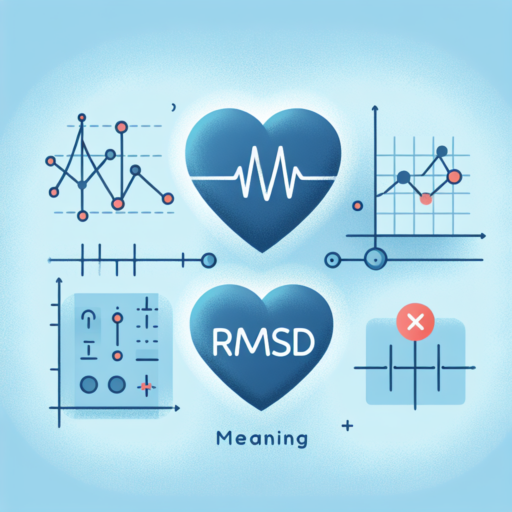Understanding RMSSD: A Complete Guide
The concept of RMSSD (Root Mean Square of Successive Differences) is pivotal in the realm of heart rate variability (HRV) analysis. Primarily used to assess the parasympathetic nervous system’s activity, RMSSD plays a critical role in evaluating stress, recovery, and overall cardiovascular health. By examining the time difference between successive heartbeats, RMSSd provides insights far beyond what the average heart rate can offer.
Understanding RMSSD is essential for both athletes looking to optimize their performance and individuals seeking to improve their wellbeing. This metric is a window into the autonomic nervous system, revealing the intricate balance between the sympathetic (fight or flight) and parasympathetic (rest and digest) branches. The higher the RMSSD value, the greater the heart’s ability to switch gears and respond to stress or relaxation cues effectively.
To dive deep into the significance of RMSSD, one must not only focus on its theoretical framework but also on its practical applications. For instance, by monitoring RMSSD, individuals can track their stress levels, recovery status, and even predict potential health issues before they become serious. It has become an invaluable tool in personalized health monitoring and performance optimization strategies.
What Does RMSSD Mean and Why It Matters?
The term RMSSD stands for Root Mean Square of the Successive Differences. It’s a measure used primarily in the field of heart rate variability (HRV) analysis, which calculates the variability in the time interval between heartbeats. Understanding RMSSD is crucial because it provides insight into the autonomic nervous system’s (ANS) function, particularly reflecting the activity of the parasympathetic nervous system, also known as the rest-and-digest system.
RMSSD is significant not only for athletes looking to optimize their training and recovery but also for individuals monitoring stress and cardiac health. It is one of the most reliable metrics used in short-term HRV measurements because it’s less influenced by external factors, making it a consistent marker of vagal tone—the activity of the vagus nerve that controls heart rate, digestion, and other body functions. Therefore, a higher RMSSD value typically indicates better cardiovascular health, higher stress resilience, and more efficient recovery from physical and mental exertion.
Measuring RMSSD can offer valuable data about one’s overall well-being and fitness level. For example, tracking changes in RMSSD over time can help identify patterns related to stress, fatigue, and even the onset of potential health issues before they become more significant. Consequently, incorporating RMSSD analysis into regular health and fitness assessments provides a deeper understanding of how lifestyle, training, and stress impact the body, offering a path to more tailored and effective wellness strategies.
The Importance of RMSSD in Heart Rate Variability (HRV) Analysis
Understanding the complexities of heart rate variability (HRV) is critical for both researchers and practitioners in the field of health and wellness. RMSSD, or the Root Mean Square of Successive Differences, stands out as a significant metric in the analysis of HRV. This particular measure is essential for assessing the autonomic nervous system, especially its parasympathetic branch, which is often referred to as the «rest and digest» system.
One of the reasons RMSSD is highly regarded in HRV analysis is due to its ability to reflect the activity of the vagus nerve. The vagus nerve plays a crucial role in regulating heart rate under various physiological conditions. Consequently, a deeper insight into RMSSD values can help in understanding how well the parasympathetic nervous system is functioning. This is particularly important in the context of stress response, where RMSSD can be used as an indicator of the body’s ability to adapt and recover.
Moreover, in the realm of sports science and athlete performance optimization, RMSSD has gained traction as a reliable marker. Athletes, coaches, and sports scientists leverage RMSSD data to tailor training regimens that optimize recovery and performance. By monitoring changes in RMSSD, they can assess the impact of physical stressors on the body and adjust training intensity accordingly. Thus, the importance of RMSSD in HRV analysis cannot be overstated, as it provides invaluable insights into the physiological state and resilience of an individual.
How to Calculate RMSSD and Interpret Its Values
Understanding the Root Mean Square of Successive Differences (RMSSD) is essential for professionals and enthusiasts in the fields of cardiology, sports science, and stress management. This key indicator helps assess autonomic nervous system function, specifically heart rate variability (HRV). Calculating RMSSD can provide critical insights into an individual’s heart health and stress levels. Here, we delve into the method of calculating RMSSD and offer guidance on interpreting its values effectively.
To calculate RMSSD, you start by measuring the intervals between heartbeats (typically in milliseconds) over a specific time. You then calculate the differences between successive intervals, square these differences, and calculate the mean (average) of these squared differences. Finally, the square root of this mean gives you the RMSSD value. This process can be summarized in the equation: RMSSD = √(mean(square(root of successive differences between heartbeats))). Computing RMSSD may seem complex, but various software and tools have simplified it, allowing for easier calculation and analysis.
Interpreting RMSSD values requires understanding their context within HRV metrics. Higher RMSSD values generally indicate higher heart rate variability, which is often associated with better cardiovascular health and stress resilience. Low RMSSD values may suggest lower HRV, pointing towards higher stress levels or potential heart health issues. However, it is crucial to compare RMSSD values against normative data or individual baseline measurements for accurate interpretation. Health professionals often use RMSSD in conjunction with other HRV metrics to gain a comprehensive picture of an individual’s autonomic nervous system health.
Comparing RMSSD to Other HRV Metrics
When exploring the landscape of Heart Rate Variability (HRV) metrics, RMSSD (Root Mean Square of the Successive Differences) emerges as a pivotal figure due to its unique focus on the parasympathetic nervous system’s activities. Unlike other HRV metrics that may encapsulate a broader overview of heart health or are more sensitive to the sympathetic nervous system, RMSSD specifically hones in on short-term variations in heartbeats, providing detailed insights into our body’s capacity to recover and manage stress.
SDNN (Standard Deviation of NN Intervals) is another widely recognized HRV metric that, while offering valuable information about overall heart health, presents a contrast to RMSSD by capturing both short-term and long-term heart rate variability. This breadth of analysis means SDNN can reflect changes influenced by circadian rhythms or physical activity, potentially overshadowing the subtleties that RMSSD reveals about parasympathetic activity, making it crucial to distinguish their applications when assessing HRV.
In addition to SDNN, LF/HF ratio (Low Frequency/High Frequency ratio) stands as a key metric for understanding the balance between sympathetic and parasytext-align:rightthetic nervous system activities. However, its interpretation can be complex, as it encompasses a broader spectrum of autonomic functions. In contrast, RMSSD offers a more straightforward, focused insight into relaxation and stress recovery processes, often making it a preferred choice for studies and applications centered around stress management and mental health.
Exploring these differences is essential for researchers, clinicians, and individuals aiming to harness HRV metrics for health and performance optimizations. While RMSSD provides a lens into the nuanced aspects of parasympathetic regulation, other metrics like SDNN and LF/HF ratio offer a wider gaze into the autonomic nervous system’s overall functioning. The choice between them hinges on the specific objectives of HRV analysis, whether it’s the broad assessment of heart health or a targeted investigation into stress and recovery dynamics.
No se han encontrado productos.
RMSSD: Implications for Health and Fitness Monitoring
The Root Mean Square of Successive Differences (RMSSD) is emerging as a key metric in the health and fitness industry, particularly for its implications in monitoring and enhancing athletic performance and overall well-being. As an integral part of heart rate variability (HRV) measurements, RMSSD offers valuable insights into the autonomic nervous system, specifically reflecting the parasympathetic activity. This information is paramount for both individuals striving for peak physical condition and those looking to improve their health metrics.
Understanding the nuances of RMSSD can empower athletes and fitness enthusiasts to finely tune their training regimens. By monitoring fluctuations in RMSSD, individuals can gauge their body’s response to stress and training loads, enabling a more personalized approach to exercise and recovery. This not only enhances performance but also minimizes the risk of overtraining, which can lead to injury or burnout. Consequently, the emphasis on RMSSD in fitness and wellness programs is growing, highlighting its importance in achieving optimal health and athletic achievements.
Moreover, RMSSD tracking tools have become increasingly accessible, integrating seamlessly into wearable technology and fitness apps. This democratization of health monitoring tools allows for daily tracking of RMSSD, offering immediate feedback on one’s physiological state. It encourages a proactive approach to health and fitness, where data-driven decisions can lead to improved outcomes. Whether for managing stress, enhancing athletic conditioning, or monitoring recovery, RMSSD serves as a critical indicator of autonomic nervous system health and overall fitness levels.
Tools and Technology for Measuring RMSSD
Understanding Root Mean Square of the Successive Differences (RMSSD) is pivotal for professionals and enthusiasts in the health and wellness sphere, particularly in the context of heart rate variability (HRV). With the advancement in tools and technology, measuring RMSSd has become more accessible and reliable, serving as a foundational element in assessing cardiac health and fitness levels.
Traditionally, the assessment of RMSSD required sophisticated medical equipment, often accessible only in clinical settings. However, recent years have witnessed the emergence of portable and consumer-friendly devices and applications designed specifically for this purpose. Wearable technology, such as smartwatches and fitness bands, now come equipped with sensors capable of continuously monitoring heart rate variability, providing real-time RMSSD data alongside other vital health metrics.
Moreover, the integration of artificial intelligence (AI) and machine learning algorithms with these wearable devices has significantly enhanced the accuracy and reliability of RMSSD measurements. Software applications, both standalone and as part of a larger ecosystem, allow users to track their RMSSD over time, offering insights into their stress levels, recovery status, and overall cardiovascular health. These applications often come with features like trend analysis, personalized recommendations, and the ability to share data with healthcare providers, making them invaluable tools in the pursuit of optimal health and fitness.
The Role of RMSSD in Stress and Recovery Management
The importance of RMSSD (Root Mean Square of the Successive Differences) in understanding bodily responses to stress and the management of recovery is profound. RMSSD has emerged as a critical metric in the context of Heart Rate Variability (HRV), offering insights into the autonomic nervous system’s (ANS) dynamics. By analyzing RMSSD, individuals and health professionals can gain a deeper understanding of how stress influences the body and develop more effective recovery strategies.
RMSSD primarily reflects the activity of the parasyptic nervous system, which plays a crucial role in relaxation and recovery. When stress levels rise, variations in heart rate also increase, and RMSSD measures these variations to assess stress impact. This measurement can be particularly beneficial in designing personalized stress management and recovery programs. By observing changes in RMSSD, it becomes possible to identify stressors more effectively and adjust recovery efforts accordingly.
Moreover, the application of RMSSD in recovery management extends beyond mere stress analysis. It serves as a guide for implementing relaxation and recovery techniques, such as meditation, guided breathing, and physical rest. Tracking RMSSD over time can help individuals recognize patterns in their stress responses and recovery processes, facilitating a more tailored approach to well-being and mental health.
Understanding RMSSD Measurements
- Insight into Autonomic Nervous System activity
- Identification of personal stress triggers and recovery patterns
- Enhanced personalization of stress management strategies
RMSSD: Best Practices for Athletes and Coaches
The Root Mean Square of the Successive Differences (RMSSD) is a crucial metric in heart rate variability (HRV) analysis, offering athletes and coaches deep insights into the body’s recovery states and stress levels. Implementing RMSSD best practices can elevate an athlete’s performance by optimizing recovery and training schedules. Understanding and applying these practices effectively is key to harnessing the full potential of HRV data for athletic optimization.
Integrating RMSSD into Daily Training Routines
To reap the benefits of RMSSD, incorporating it into daily training routines is essential. Athletes and coaches should prioritize regular HRV assessments, ideally in the morning, to gather consistent data. This consistency allows for more accurate tracking of trends over time, enabling the optimization of training intensity based on the body’s readiness to perform. Moderation is key; while daily measurements are beneficial, there should be a balance to avoid obsession with numbers and ensure the focus remains on overall well-being and performance.
Understanding RMSSD Fluctuations
Recognizing the factors that influence RMSSD fluctuations is vital for effective interpretation and application. Stress, sleep quality, nutrition, and training load can all significantly impact RMSSD readings. Therefore, athletes and coaches need to look beyond the numbers and consider these external factors when making training decisions. A holistic approach, considering both RMSSD data and lifestyle factors, ensures a more comprehensive and effective training strategy.
By embracing RMSSD best practices, athletes and coaches can significantly enhance training outcomes. Emphasizing consistent, integrated assessment and a holistic interpretation of data leads to better-informed decisions, fostering a training environment that supports peak performance and health. Engaging with RMSSD is not just about optimizing athletic performance; it’s about promoting a well-rounded approach to athlete health and recovery.
Understanding the Limitations and Challenges of RMSSD Analysis
While the Root Mean Square of Successive Differences (RMSSD) is a valuable tool in assessing heart rate variability and autonomic nervous system activity, its application comes with several limitations and challenges that must be carefully considered. One primary limitation is the inherent complexity of the signal it analyzes. The RMSSD is highly sensitive to very short-term variations in heart rate, which means it can be significantly influenced by various factors, including breathing patterns, postural changes, and even momentary stressors. This sensitivity, while beneficial for capturing intricate details of heart rate variability, can also lead to variability in results, making it challenging to achieve consistent measurements across different contexts and time periods.
Accuracy and Interpretation Challenges
Another significant challenge in RMSSD analysis lies in the accuracy and interpretation of the data it generates. The mathematical nature of RMSSD calculation demands precise data collection and preprocessing, which can be difficult to standardize. Artifacts in the data, such as ectopic beats or noise from movement, can lead to inaccurate RMSSD values if not properly addressed. Furthermore, the interpretation of RMSSD results is not always straightforward. While higher RMSSD values are generally associated with higher parasympathetic activity, making generalized conclusions without considering the context of each individual measurement can be misleading.
Technological and Operational Limitations
The effectiveness of RMSSD analysis is also influenced by technological and operational factors. The quality of the devices used to collect heart rate data can vary significantly, affecting the fidelity of the RMSSD calculation. Moreover, the requirement for short-term, high-quality ECG or HRV recordings means that any operational shortcomings, such as improper sensor placement or inadequate recording environments, can adversely affect the outcome. These technological and operational limitations necessitate a rigorous standardization of procedures and equipment to ensure the reliability of RMSSD analysis.




